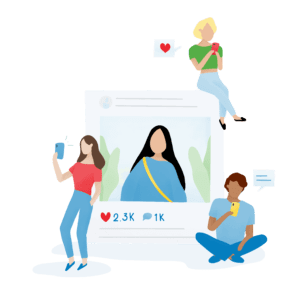Influencer marketing has a comfortable seat on the growth path as one of the fastest growing subsets of marketing. It increased from a $1.7B industry in 2016 to a $3.0B industry in 2017, climbing to a $4.6B industry in 2018 and projected to become a $6.5B industry in 2019.
But what are influencers? How are they useful to marketers? And what kinds of brands benefit?
An influencer is someone, typically with an impressive online presence, able to impact consumers’ purchase decisions mostly because of their relationship with their audience and followers. The bulk of influencer marketing occurs on social media platforms like Instagram or YouTube. It’s especially effective when the influencer’s audience embodies a particular niche, which makes them more engaged and enthusiastic.
Influencers are incredibly valuable because they allow marketers to reach their target audience through someone the audience already knows, likes, and trusts. Any brand can benefit from influencer marketing, but keep in mind your audience – it’s more likely to be effective with Gen Z & Millennials than Gen X & Baby Boomers. Influencer marketing is also great for brands wanting to increase brand awareness, build long-term partnerships, and foster trust & authority.
The Social Proof to Prove It
 In psychology, social proof refers to the idea that people will look to what others do in situations similar to theirs in order to figure out the “right” thing to do. In marketing, social proof could be product reviews, case studies, social media commentary, and, of course, influencer marketing, to name a few.
In psychology, social proof refers to the idea that people will look to what others do in situations similar to theirs in order to figure out the “right” thing to do. In marketing, social proof could be product reviews, case studies, social media commentary, and, of course, influencer marketing, to name a few.
Product information or endorsements coming from someone who consumers already see as authentic and trustworthy can have a drastically positive impact on buying behaviors. A successful influencer marketing strategy has the potential to get your brand in front of your perfect target audience. This audience is already guaranteed to have a moderate to high degree of trust in the way your product is being presented, as they already trust the spokeperson.
In terms of the customer’s path to purchase, influencer endorsement is most effective near the beginning of the buying journey. Other social proof like testimonials and reviews are more effective as consumers make their way down the funnel and compare brands.
Don’t Sleep on Gen Z
As mentioned, influencer marketing is more effective on Gen Z & Millennials (especially Gen Z) than other generations. But just how effective is it?
According to Trustpilot data, 66% of Gen Z survey respondents are more likely to purchase a product endorsed by an influencer, compared to 43% of Baby Boomers. Even more significant, 53% of Gen Z is more likely to purchase a product with public figure endorsement, compared to 19% of Baby Boomers.
There are several possible reasons for this. First of all, Gen Z grew up with the internet in the palms of their hands, and have grown to expect their favorite influencers to post content with hashtags like #ad and #spon. Additionally, Gen Z likes brands to reach them on social media more than Millennials do, favors YouTube to Amazon (while Millennials are the opposite), and prefer ads featuring celebrities to ads creating an emotional connection (while, again, Millennials are the opposite).
As Gen Z grows to dominate the consumer scene (they’re set to beat out the Millennial population as soon as 2026), brands that want to grow will need to account for Gen Z when crafting their marketing strategy.
YouTube + Instagram: Top Influencer Marketing Channels
 YouTube and Instagram are two of the biggest platforms that the latest generations of consumers flock to for both entertainment and information. And regarding influencer marketing specifically, they’re the top two social media channels.
YouTube and Instagram are two of the biggest platforms that the latest generations of consumers flock to for both entertainment and information. And regarding influencer marketing specifically, they’re the top two social media channels.
Don’t limit yourself to thinking that advertising on YouTube or Instagram is only about getting your ads onto someone’s feed. These platforms are inundated with influencers who can plug your product. And with 1.9 billion and 1.0 billion monthly active users respectively, these platforms present a major opportunity for your brand to reach a wide variety of users or a specific subset of user – whatever your strategy needs.
Video is at the core of both of these platforms (especially YouTube), which is great for marketers because it means viewers are more likely to be paying attention to both what they’re seeing and what they’re hearing. And since they’re both such visual platforms (especially Instagram), you have a major opportunity to showcase your brand in an aesthetically pleasing way. A picture (or video?) speaks a thousand words!
There are a few things you’ll need to keep in mind before launching your influencer marketing campaign on either of these platforms, though. Make sure you have a thorough understanding of your target audience, know the different tiers of creators on both platforms, and explore the followers of your targeted influencers to ensure your campaign lands in front of the right sets of eyes.
One thing to keep in mind is that just because an influencer has lots of followers doesn’t mean they’ll be valuable to your brand. In fact, sometimes, brands can find the most value in micro-influencers, individuals with a niche audience of 1,000-100,000 social media followers. Micro-influencers are becoming a more popular avenue because they see higher engagement rates and offer the opportunity for brands to target a specific customer type.
This is because micro-influencers cater to niche audiences who are hyper-interested in the content they produce, while individuals with a much larger following will have a more mixed audience. This also means that micro-influencers tend to bring higher conversion rates. They’re great for more down-to-earth, relatable marketing, and are usually more affordable than larger influencers. (Note: A good rule of thumb is to pay $1,000 per 100,000 followers.)
If you’re interested in other social media advertising opportunities, check out some of our additional resources below:
- The 2019 Facebook Full-Funnel Report: Data + Insights for Social Media Advertising Success
- YouTube Advertising: Success on the World’s Second Largest Search Engine
- Facebook Video: Take Your Advertising Creative to the Next Level
- Optimizing Mobile Ads on Facebook & Instagram
- Why Social Media Needs to Be at the Top of Your Marketing Funnel



